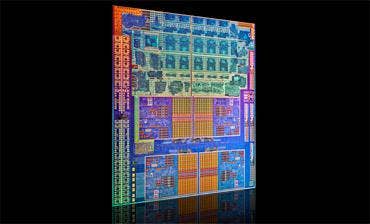Review: AMD's Fusion Comes To The Desktop

No need for video card when there's Fusion, AMD's new low-cost all-in-one desktop processor
Advanced Micro Devices on Thursday begins shipping its latest AMD Fusion processor -- code-named Lynx -- the desktop version of its CPU/GPU released earlier this month for laptops. The so-called APU, or accelerated processing unit, combines as many as four x86 cores and 400 AMD Radeon HD graphics cores on a single chip.
AMD's A-series parts are designed to compete with Intel's Core i5 and Core i3 processors in terms of price. But as far as graphics processing capabilities, AMD claims that Fusion is on par with discrete video controllers. The new series also offers relatively low power usage, with thermal displacement specs between 65W and 100W; also on par with Intel. All A-series chips support memory speeds up to 1866 MHz, when it becomes widely available.
The new APUs incorporate the "AMD Vision Engine," which the company has deemed the combination of its video accelerator, Radeon cores and Catalyst and OpenCL drivers and the Windows-based control center UI.
For testing in advance of the launch, AMD sent the CRN Test Center its high-end A8-3850 APU, a 100W part with four x86 cores running at 2.9 GHz, 400 Radeon cores at 600 MHz, plus 5 SIMD units, 20 texture units and 42 additional processors. The A8-3850 came pre-installed on an ASRock A75 Pro4 motherboard, to which testers added 4GB of 1333 MHz DDR3 memory, an OWC 256GB Mercury Extreme 6Gb/s SSD, and 64-bit Windows 7 Ultimate N.
Next we installed our usual array of system and graphics performance benchmarks, which include Geekbench (currently 2.1.13) from Primate Labs, and Codemasters Software's Dirt 2. To measure frame rates, we used Real Time HDR IBL and Fraps 3.2.2 from Beepa Pty Ltd. Vertical sync was disabled.
Click image for full-sized view.
Next: Geekbench Results
Geekbench displayed a maximum score of 6420, which is in line with Core i5-based systems we've tested. Raw rame-rate performance measured by Softonic's Real Time HDR IBL peaked at 160 FPS at 640 x 480 and 4x multi-sampling, and dropped to 88 FPS at 1024 x 768, 48 FPS at 1440 x 900 and 30 FPS at 1920 x 1080.
In Dirt 2, Codemasters' awesome driving game, frame rates were a mixed bag. We played the game in full screen mode at 1440 by 900 and saw a peak rate of 247 FPS, another of 147 FPS and a sustained rate of about 33 FPS during game play.
To handle CPU and GPU traffic through the processor socket, the new A-series parts require an all-new infrastructure, and major OEMs are on board at launch time. These include ASRock, ASUS, Foxconn, Gigabyte, MSi and others. AMD's new FM1 socket is soldered to the motherboard, unlike Lynx's kid-brother Brazos, which attached with a BGA. However, many older heatsinks are compatible, including those from sockets AM2, AM2+, AM3 and AM3+. AMD says that any heatsink designed for its Athlon II (95W or higher) should adequately cool the Lynx.
AMD's new Fusion processors provide enough graphics horsepower to satisfy many of the most power-hungry executives, and we believe it will make a strong showing in that market segment. At the same time, Lynx chips also can support dual graphics; meaning they can combine their GPUs with those of discrete video cards. This is important for the gaming segment, because the graphics processing performance of the Fusion alone will be inadequate, and would otherwise be wasted or cause them to seek other products.
With production set to ramp up in July, the high-end Fusion A8-3850 will sell for around $135, and the A6-3650 will cost around $115. The low-end chip too has four x86 cores, but runs at 2.6 GHz and includes 320 Radeon cores running at 443 MHz. AMD also will offer 65-watt versions of both, but pricing and availability have not been disclosed.